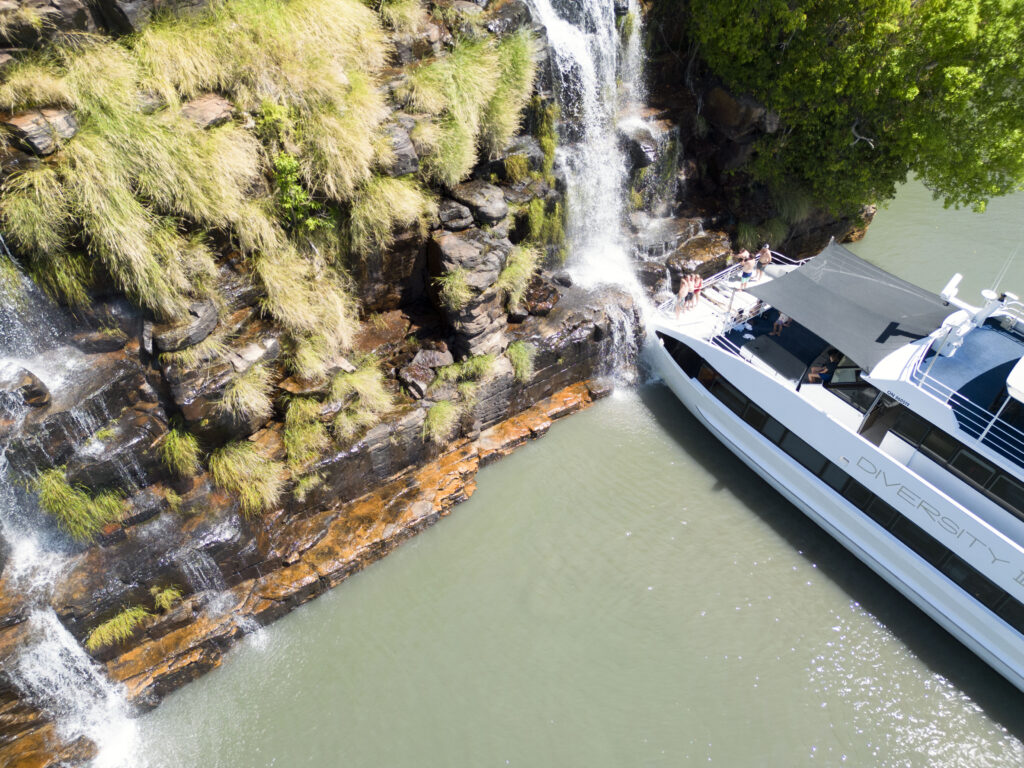Kimberley Bird Guide
Written by the staff of Coral Expeditions. Check out all cruises by Coral Expeditions here.
For bird lovers, the pursuit and discovery of birds is a source of endless fascination and delight. When one becomes interested in birds, you begin to watch them, and grow curious about their names, their habits, their migratory patterns, and what they eat. Birders learn to tune in to the natural world that is always around them, allowing a deeper connection to Nature. Whether it is a tiny Azure Kingfisher in mangroves, Brolgas with their elegant dance and connection to the mythology of Australia’s Top End, or an Osprey diving on an unsuspecting fish; you don’t have to be a birdwatcher to appreciate these extraordinary creatures in the wild.
Read on to learn more about the most commonly seen species of birdlife on an expedition cruise to the Kimberley, and what species to keep an eye out for on an expedition adventure of the Kimberley coastline.
Eastern Osprey (Pandion cristatus)
This large raptor reaches up to 180cm across the wings. It builds a large nest structure of sticks and driftwood, which is used year after year. The Osprey primarily eats fish, sighting prey from the air before plunging feet-first into the water. The top predator of the skies in the Kimberley, the Osprey is often seen along the Kimberleys’ rocky coastal cliffs. In September, you might be lucky enough to see the chicks leaving the nest and taking first flight!
It is interesting to note that Ospreys are sedentary and will remain at one nest site for many years. Ospreys use the same site each breeding season, adding several larger sticks so that over time some nests can be over a metre in height. Almost every bay and island has a resident pair of Osprey and each year they construct huge nests on rocky outcrops where the young are safe from predators

White-bellied Sea Eagle (Haliaeetus leucogaster)
The White-bellied Sea Eagle is the second largest raptor in Australia with a wingspan around two metres (females can be larger). These magnificent birds are fierce predators and very successful hunters of fish, birds, sea snakes and small mammals especially Black Flying Fox, one of their favourite foods. They build a large nest of sticks usually in trees although they occasionally choose rocky locations in the Kimberley. Much of the White-bellied Sea Eagle’s behaviour remains poorly known. They can be spotted on our Kimberley cruise nesting or hunting, and are always a magnificent sight. The White-bellied Sea Eagle is easily identified in flight by its large upswept wings.
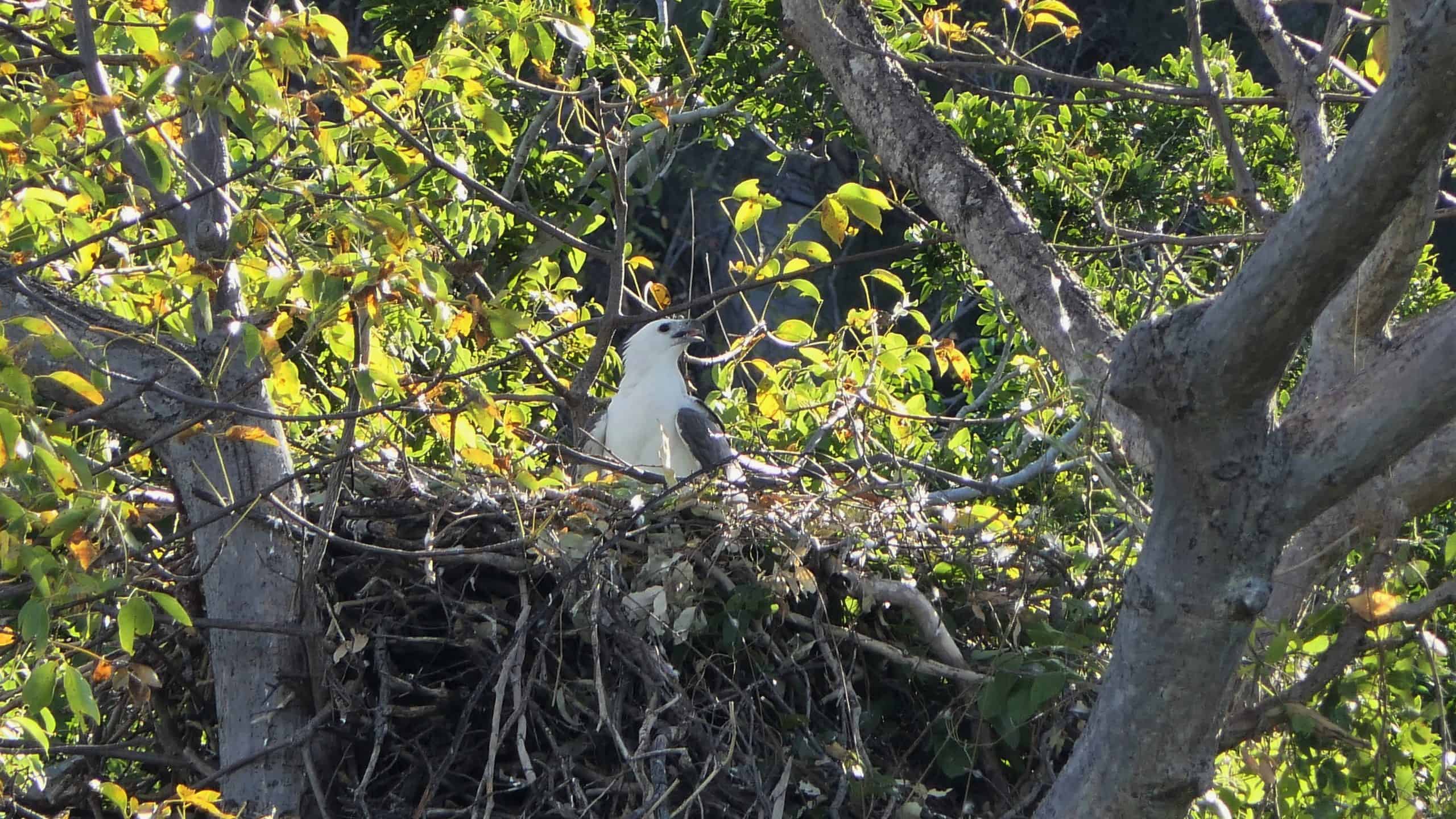
Brahminy Kite (Haliastur indus)
The Brahminy Kite is a medium-sized bird of prey that is commonly seen in the mangroves of the Kimberley. With its russet brown and white feathers, this striking bird stands out when perched in a mangrove tree. It is primarily a scavenger taking any opportunity to pick up dead fish or crabs and they will often steal food from other birds. It builds a nest of sticks that is well-hidden in the mangroves.
Eastern Reef Egret (Egretta sacra)
The Pacific reef heron, also known as the eastern reef heron or eastern reef egret, is a species of heron found throughout southern Asia and Oceania. With their striking long necks, egrets tend to stand out from the crowd along the Kimberley shoreline. This water bird is mostly white, while its bill and other facial skin is yellow in colour. It is important to note that these colours are subject to change during the breeding season.
Egrets can be found around shallow water, but they also frequent other waterways such as lagoons, estuaries and coastal inlets. Due to their unique body shape, egrets hunt by either standing and prodding their beaks at the prey or by wading carefully through the shallow water.
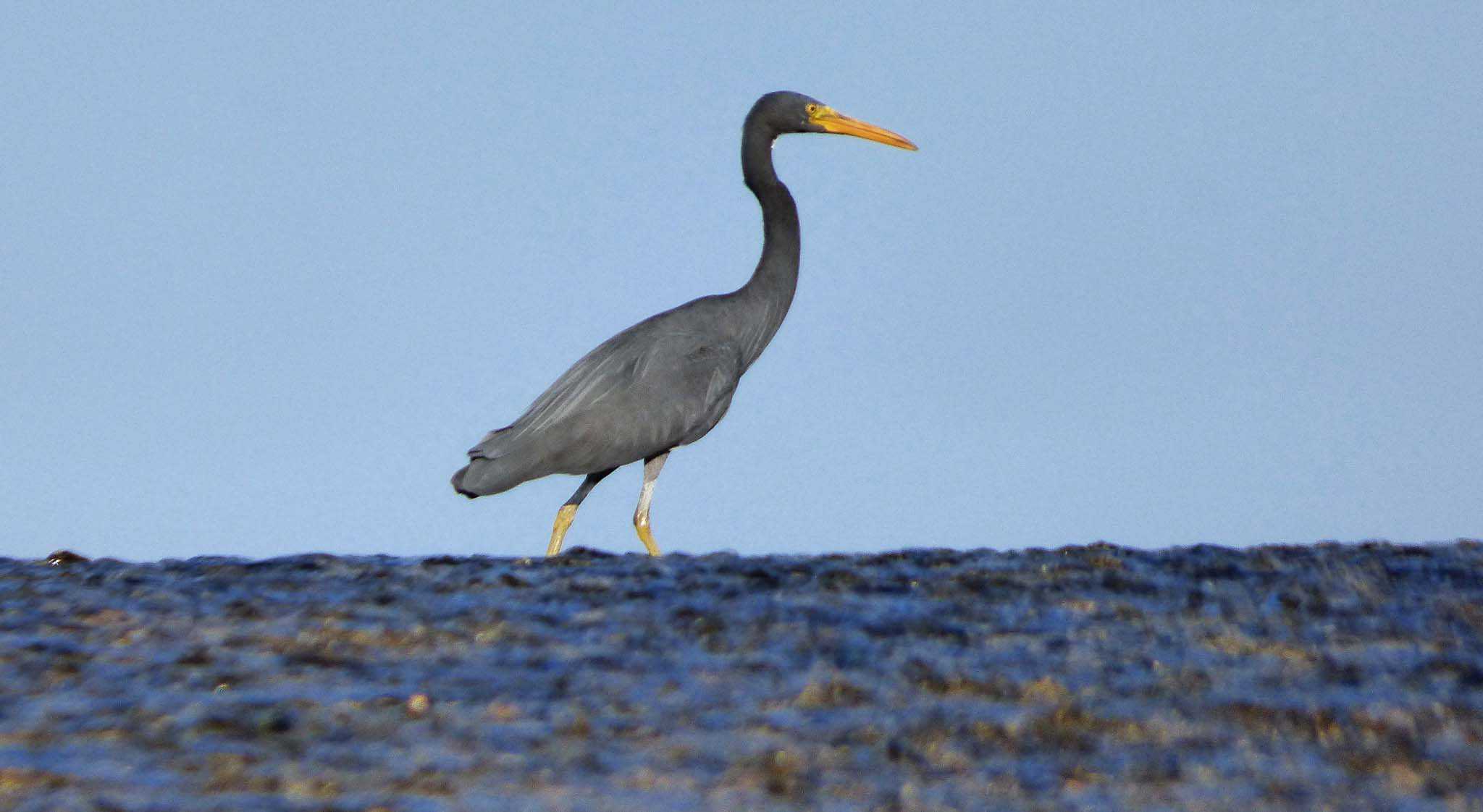
Beach Stone Curlew (Esacus magnirostris)
The Beach Stone-Curlew is also known as beach thick-knee is a large, ground-dwelling bird that occurs in Australasia, the islands of South-east Asia. At 55 cm and 1 kg, it is one of the world’s largest shorebirds. They usually inhabit sandy beaches that are lined with mangroves, resting in the shade during the heat of the day and become active around sunset, slowly stalking their prey, much in the manner of a heron, interspersed with quicker, plover-like dashes. They mainly eat crabs and other marine invertebrates. Beach Stone-curlews are secretive birds and are easily disturbed by people. In areas where there is much disturbance, they are shy, but in remote areas like the Kimberley, they can be more confident.
The Beach Stone Curlew is a shy bird and difficult to approach. They are almost always seen in pairs and hunt along the shore and reef for crabs and marine invertebrates. They are often seen on the exposed reef at Montgomery Reef hunting for small crabs and mantis shrimp. During the annual breeding season, the female lays a single egg on the beach above high tide. If the first egg is lost, she may lay one more.
The Beach Stone Curlew usually inhabits sandy beaches that are lined with mangroves, resting in the shade during the heat of the day. They become active around sunset, slowly stalking their prey, much in the manner of a heron, interspersed with quicker, plover-like dashes. They mainly eat crabs and other marine invertebrates. Beach Stone-curlews are secretive birds and are easily disturbed by people. In areas where there is much disturbance, they are shy, but in remote areas like the Kimberley, they can be more confident.

Striated Heron (Butorides striata)
The striated heron also is known as mangrove heron, little heron or green-backed heron, is a small heron, about 44 cm tall. Striated herons are mostly non-migratory and noted for some interesting behavioural traits.
An adult bird was once observed in a peculiar and mysterious behaviour: while on the nest, it would grab a stick in its bill and make a rapid back-and-forth motion with the head, like a sewing machine’s needle. The significance of this behaviour is completely unknown: While such movements occur in many other nesting birds where they seem to compact the nest, move the eggs, or dislodge parasites, neither seems to have been the case in this particular striated heron.
Caspian Tern (Hydroprogne caspia)
Australia’s largest tern, the Caspian Tern is easily identified by its large, bright-red, dagger-like bill. They forage by plunge-diving into the water from heights of up to 15 metres, grabbing a fish with that massive beak. They usually feed by shallow plunging; hovering up to 15 m above the water with bill pointing down before folding wings in and diving, fully submerged, to quickly re-emerge. They usually swallow fish in flight, head first. Most feeding activity is in the early to mid-morning. Whole fish are regurgitated to feed the young.
Sacred Kingfisher (Todiramphus sanctus)
A common kingfisher in the Kimberley is the Sacred Kingfisher and we see this bird perched on the lower branches of mangroves in any of the numerous creeks and estuaries along the coast. Another more elusive kingfisher is the beautiful Azure Kingfisher. Both species are seen in the mangroves and occasionally we see them hunting small crabs on the exposed mud banks. The Torresian Kingfisher (also called Collared or Mangrove Kingfisher) has been recorded on the Kimberley coast but is not often seen.
Sacred Kingfishers are a common sight in and amongst the mangroves of the Kimberley Coast. Distinguishable with their turquoise back, turquoise blue rump and tail and white/cream colour, these birds are well-suited for the coastal environment. As they mostly hunt from the land or a perch, the birds feed on everything from insects and reptiles to crustaceans. Fish are certainly down the pecking order for the Sacred Kingfisher.
During your Kimberley expedition, keep your ears ready for the distinctive sounds of the Sacred Kingfisher. Described as a “kee kee kee”, this is both an excitement and warning voice to other Kingfishers. It is also heard repeatedly during the breeding season.

Brown Booby (Sula leucogaster)
Once thought of as a bit simple, the Brown Booby was named after a Spanish word bobo meaning clown. Despite its apparent clumsy appearance, this large seabird with a wingspan of about 1.5m is superbly adapted for a life at sea with webbed feet, excellent vision, and an acute sense of smell. They hunt by plunge-diving on schools of fish and squid submerging about two or three metres in pursuit of their prey. To cope with the impact of hitting the sea surface at speed, they have with a spear-shaped bill, forward-facing eyes with special eyelids and nostrils located inside the bill.
The Lacepede Islands are home to many important bird rookeries and nesting sites, including one of the largest colonies of Brown Boobies in the world (18,000 pairs spread out over the Lacepede island group). Brown Boobies couple for many seasons, laying blue eggs and hatching very fluffy white chicks that soon become the same size as the parents!
Along the Kimberley Coast, there are several species of boobies which could be spotted. This includes the Brown Booby, Red-footed Booby and Masked Booby. Boobies are commonly mistaken for gannets and are actually part of the same family. These three booby species have very similar features, but ultimately have telltale differences to separate them; the Brown Booby has a brown tint to its underparts and breast, the Red-Footed Booby has reddish-pink legs, while the Masked Booby has a black trim mask around its eyes. Of course, each Booby species is unique and your onboard birdlife expert can explain why these creatures are an important part of the Kimberley Coast’s ecosystem.

Australian Pied Oystercatcher (Haematopus longirostris)
The Pied Oystercatcher is commonly seen in the inter-tidal zone of beaches and bays where it forages on exposed sandbanks for molluscs, worms, crabs and small fish. The Oystercatcher’s name comes from its specialised bill that can be used to pry open shellfish. There are two species of Oystercatchers on the Kimberley coast, the Pied Oystercatcher, and the Sooty Oystercatcher. Both species are medium-sized shorebirds or waders that hunt for bivalve molluscs along the shores. They also feed on bristle worms, small crabs, and other marine invertebrates. Both species breed in the Kimberley, usually laying their eggs on beaches.
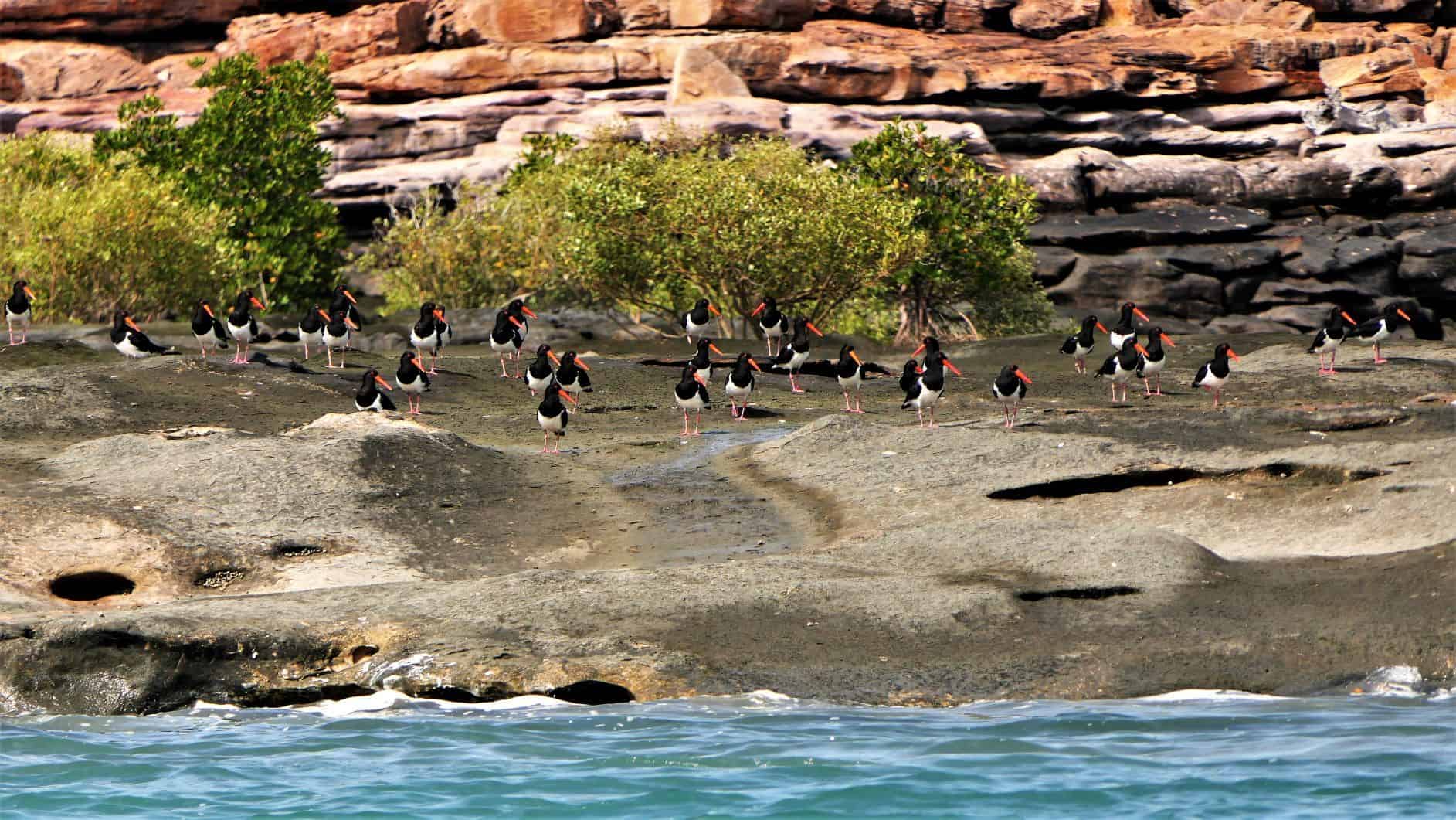
Expedition Stops
Bonaparte Gulf
Look out for Crested Terns, Lesser Frigatebird and Brown Booby. There is always the possibility of a sighting of the less common Wilson’s Storm Petrel.
King George Falls and Tranquil Bay
During a cruise through the magnificent gorge to King George Falls keep an eye out for Osprey and its huge stick nest. White-bellied Sea-Eagle, Peregrine Falcon, Eastern Reef Egret, Great Egret, Striated Heron and Darter are regularly seen in this area. On the beaches, look out for pairs of Sooty Oystercatcher and the occasional Beach Stone Curlew.
Jar Island and DC-3 site in Vansittart Bay
Many land species can be seen during a visit to the DC-3 site. On the beach look for a tiny Red-capped Plover or a Beach Stone Curlew. Regular sightings at the DC-3 site include Brown Honeyeater, Yellow-tinted Honeyeater, Bar-breasted Honeyeater, Torresian Crow, Rainbow Bee-eater, Pied Butcherbird, Red-tailed Black Cockatoo, Black-necked Stork (Jabiru), Red-winged Parrot.
On Jar Island it is common to see a Sooty Oystercatcher on the beach. Other sightings on Jar Island include Sandstone Shrike Thrush, Torresian Imperial Pigeon and a cruise around the island can reveal Crested Tern, Lesser Crested Tern, Roseate Tern, Eastern Reef Egret and Osprey.
From the Voyage Log:
We approached a large stick nest perched on top of a large rock near Jar Island and watched in amazement as an adult Osprey appeared with a fish in its talons. All of a sudden, a young Osprey popped its head up from the nest greedily eyeing the meal of fresh fish. We watched the parent Osprey tear pieces off the fish, holding it down with its talons and feeding it to the young bird. Guests managed to take some great wildlife photographs.
A Red-Kneed Dotterel is spotted by some of the group and many of us are rewarded by a good sighting of an Eagle ray jumping well out of the water as we departed the beach. On the eastern side of Vansittart Bay, a short trek over the sand dunes and tidal flats brought us to the relic of a WWII well-preserved DC3 aircraft. A Black-necked Stork, an Australian Kestrel, a Brown Falcon, a Brahminy Kite and a family of Torresian Crows were seen on the walk to the aircraft. In the bush around the plane, Brown Honeyeaters and Grey-fronted Honeyeaters noisily gorged themselves on the nectar of the orange-flowered fern leafed grevillea.
Swift Bay
The very elusive Black Grass-wren has been seen in Swift Bay but you are more likely to see Osprey, Lesser Crested Tern, Eastern Reef Egret and Striated Heron. Have a look out for the occasional, White-quilled Rock Pigeon (a Kimberley endemic species) sitting quietly on the rocks in some of the coastal inlets. Large gatherings of Pied Oystercatcher are often seen in the bay near one of the art sites along with migratory shorebirds including Grey-tailed Tattler, Greater Sand Plover, Greenshank, Pacific Golden Plover, Sharp-tailed Sandpiper, Eastern Curlew, Red-necked Stint, Whimbrel and Bar-tailed Godwit. Mangrove lined creeks in this area can be good for Red-headed Honeyeater.
Winyalkin Island and Bigge Island
The stunning rocky coast in this area is home for Osprey, White-bellied Sea Eagle, Australian Pelican, Sooty Oystercatcher & Crested Tern. Other birds often seen here include Whimbrel, Grey-tailed Tattler, Beach Stone Curlew and Torresian Imperial Pigeon. Also recorded here but not common are Little Tern, Brolga and Pied Heron.
Prince Frederick Harbour
A cruise into the mangroves in this area can be very rewarding with regular sightings of Azure Kingfisher, Sacred Kingfisher, Brahminy Kite, Whimbrel, Common Sandpiper and Striated Heron. You might even be lucky enough to see a beautiful Mangrove Golden Whistler or hear the mournful call of the Mangrove Robin. High on the cliffs look for White-bellied Sea-Eagle. Also seen here occasionally are Torresian Imperial Pigeons, Whistling Kite and Mangrove Gerygone.
From the Voyage Log:
At Mitchell Falls we see wood swallows, a Black-breasted Buzzard, a Wedge-tailed Eagle, Mudlarks and a White Quilled Rock Pigeon amongst other birds. Later, while exploring Porosus Creek, a close view of a ‘salty’ (saltwater crocodile) and sightings of a Great-billed Heron makes guest Norma’s day. Good sightings of Osprey, White-bellied Sea-eagles with active nests as well as Sacred and Azure Kingfishers are a bonus.
Naturalist Island
The Western Australian Field Naturalists Club conducted several surveys of the flora and fauna of the island from 1984 to 2007. During their surveys, they recorded 80 species of birds including Orange-footed Scrubfowl, Rainbow Pitta, Rose-crowned Fruit Dove and Emerald Dove, species that prefer and are mostly restricted to the rainforest. White-quilled Rock Pigeon, a species only found in the Kimberley was also recorded on the island.
Careening Bay
Careening Bay is the site of the famous Mermaid Tree, but it is also a great place for small bush birds that can be heard calling more often than seen. Bar-shouldered Doves call throughout the day. Great Bowerbirds are common here and a bower was in the mangroves behind the Mermaid Tree but was destroyed by a high tide. Also seen in the mangroves behind the beach are Shining Flycatcher, Red-headed Honeyeater, Brown Honeyeater, Black-faced Cuckoo Shrike and Little Friarbird. There are regular sightings of Beach Stone Curlew on the beach.
Prince Regent River, Camp Creek & King Cascade
Crested Terns are very common on the Prince Regent River where they are seen resting on floating logs. Brahminy Kite, Great Egret, Little Egret & Corellas are commonly seen sitting in the mangroves. Excursions into the tributaries of Prince Regent River can be very productive for Sacred Kingfisher, Azure Kingfisher, Rainbow Bee-eater, & Striated Heron. Listen out for the call (a descending series of melodious whistles) of the Kimberley Honeyeater. The elusive and uncommon Chestnut Rail (also called a ‘Mud Chicken’) can be seen in the side creeks. Occasionally Great Billed Heron are seen.
At King Cascade, there is often a Common Sandpiper at the base of the cascade. Corellas are seen getting fresh water at the top of the falls. Good spot for Sacred Kingfisher, Egrets & occasional Chestnut Rail.
At Camp Creek, there are regular sightings of Brahminy Kite, Common Sandpiper & White-bellied Sea Eagle. Along the creek to the swimming hole, small bush birds can be seen and heard such as Striated Pardalote, Black-faced Cuckoo Shrike and Rainbow Bee-eater.
From the Voyage Log:
Camp Creek provided a welcome opportunity to cool down in the shallow, fast-flowing freshwater and to observe several bird species. Black-faced Cuckoo Shrike, Little Corella, White-quilled Rock Pigeon, and numerous Rainbow Bee-eaters are observed here. A Whistling Kite, Intermediate Egret and Great Bowerbirds are also seen. A shy wren calls from the thick grass but despite several keen pairs of eyes trying to seek it out, its identity remains a mystery.
Montgomery Reef
When the tide drops on Montgomery Reef dozens of Eastern Reef Egret (white and grey forms) can be seen feeding on fish and invertebrates on the reef. Other species regularly seen include Caspian Tern, Crested Tern, Beach Stone Curlew, Grey-tailed Tattler, Pied Cormorant, and occasional Osprey. The uncommon White-winged Black Tern have been seen at Montgomery Reef.
From the Voyage Log:
We were exploring the ‘canal’ on Montgomery reef when one of the guests noticed a small grey bird flying directly towards the Explorer. It was a Black-faced Cuckoo Shrike, a land bird that would never naturally occur in this habitat. The exhausted bird collapsed into a Zodiac that was tied beside the Explorer. Our only explanation for this bird being 15 kilometres offshore on Montgomery Reef – it may have been escaping a predatory species such a Goshawk or Falcon and ended up caught in the offshore wind and blown a long way offshore. We returned it to the mainland the following morning after looking after it overnight.
When the tide drops on Montgomery Reef, dozens of Eastern Reef Egret spread out across the exposed reef searching for small fish, crabs, and molluscs.
Osprey, Caspian, and Crested Tern are often seen flying over the reef ready to pounce on unwary fish. On the mainland, in the mangroves, you might be lucky enough to find an elusive Chestnut Rail hunting crabs on the exposed mudbank or a Sacred Kingfisher in the overhanging branches of the mangroves waiting to pounce on a careless crab below. Different types of egrets and herons are found in the mangroves including Large Egret, Little Egret & Striated Heron and the large and shy Great-billed Heron.
We motor up a ‘river’ to the interior of Montgomery Reef, exposed at low tide. On the visible areas Eastern Reef Egrets, waders, Caspian Terns, a White Bellied Sea Eagle, an Osprey and numerous other birds feast on the exposed bounty.
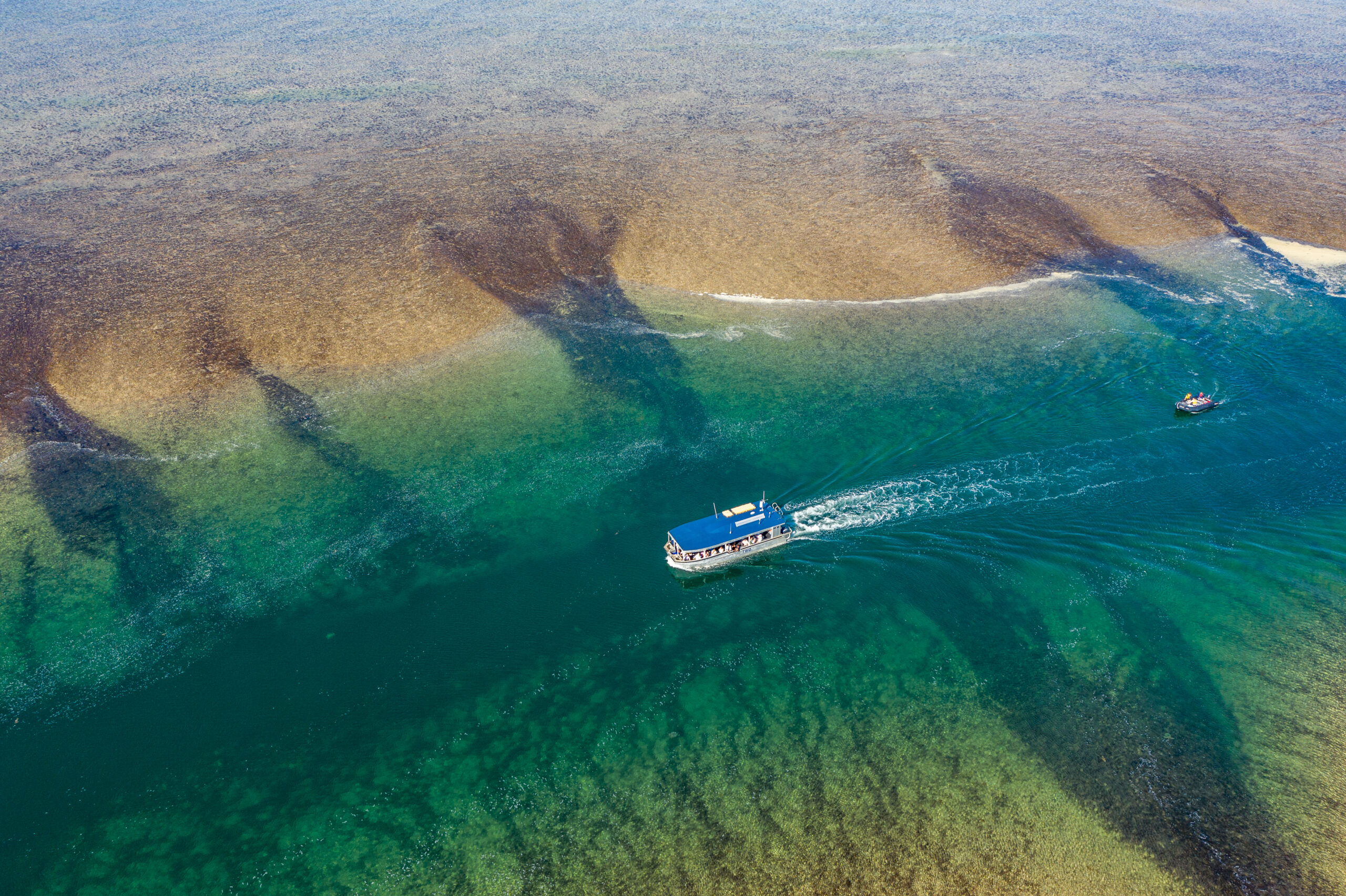
Doubtful Bay
Red Cone Creek, Ruby Falls and Three Ways Creek
Three Ways Creek is an excellent spot for birding particularly during the lower tides when mudbanks are exposed. Regular sightings of Azure Kingfisher, Sacred Kingfisher, Mangrove Robin, Rainbow Bee-eater, Whimbrel, Nankeen Night-Heron, Great-billed Heron, Common Sandpiper, White-breasted Whistler and Chestnut Rail.
Flocks of Corellas are common along Red Cone Creek as well as Brahminy Kite, Striated Heron and Whimbrel. White-quilled Rock Pigeon and White-bellied Sea Eagle are often seen around Ruby Falls and the adjacent gorge. The swimming hole at the top of the falls is a good place to see Bar-breasted Honeyeater, White-winged Triller and Brown Honeyeater.
From the Voyage Log:
We travelled far into the upper reaches of the mangrove-lined creek towards a noisy colony of Black Fruit Bats hidden in the dense vegetation. Suddenly, a White-bellied Sea Eagle appeared and started harassing the colony by flying low over the mangroves. As we watched the Sea Eagle grabbed a fruit bat and flew passed the Explorer with the struggling fruit bat in its talons. However, the fruit bat managed to escape the grip of the predator and dropped into the water. The fruit bat was unable to launch itself from the water, so it started swimming towards the mangroves a few metres away. On the other bank of the creek, one of the guests spotted a Saltwater Crocodile moving towards the stricken Fruit Bat. This all happened so quickly that few of us managed to take any photos of this spectacle of nature happening before us. The fruit bat made it to the mangroves and appeared to find a hiding spot in the tangled roots.
Raft Point, Steep Island & Bird Rock
During a cruise around Steep Island and Bird Rock, the most commonly seen species are Osprey, Sooty Oystercatcher, Eastern Reef Egret, Caspian Tern, Beach Stone Curlew. The Eastern Reef Egret, Osprey and Caspian Tern breed on Bird Rock and young are seen in the right season. In the mangrove creek on the mainland nearby look out for Red-headed Honeyeater, Striated Heron, White-breasted Whistler, White-bellied Sea Eagle, and Whimbrel.
Talbot Bay (including Horizontal Falls, Cyclone Creek)
White-quilled Rock Pigeon are often seen near the first gap of the falls on the eastern side where some freshwater seeps from the rock. During a cruise into Cyclone Creek look out for White-bellied Sea-Eagle, Striated Heron and Whimbrel. Further into Cyclone Creek regular sightings include Sulphur-crested Cockatoo, White-faced Heron, Brahminy Kite, Great-billed Heron, Wedge-tailed Eagle, White-quilled Rock Pigeon and Black-faced Cuckoo Shrike.
Iron Islands, Koolan Island & Nares Point
Several Osprey nests are seen in this area. An Osprey nest on Ballast Rock has been tended by birds for many years. Eastern Reef Egret are common around the islands and Beach Stone Curlew often seen on the beach at Ballast Rock. Other birds seen here include Black-faced Cuckoo Shrike, White-bellied Sea Eagle, and Nankeen Kestrel. At Nares Point, there is a Great Bowerbird bower located in the undergrowth at the top of the beach.
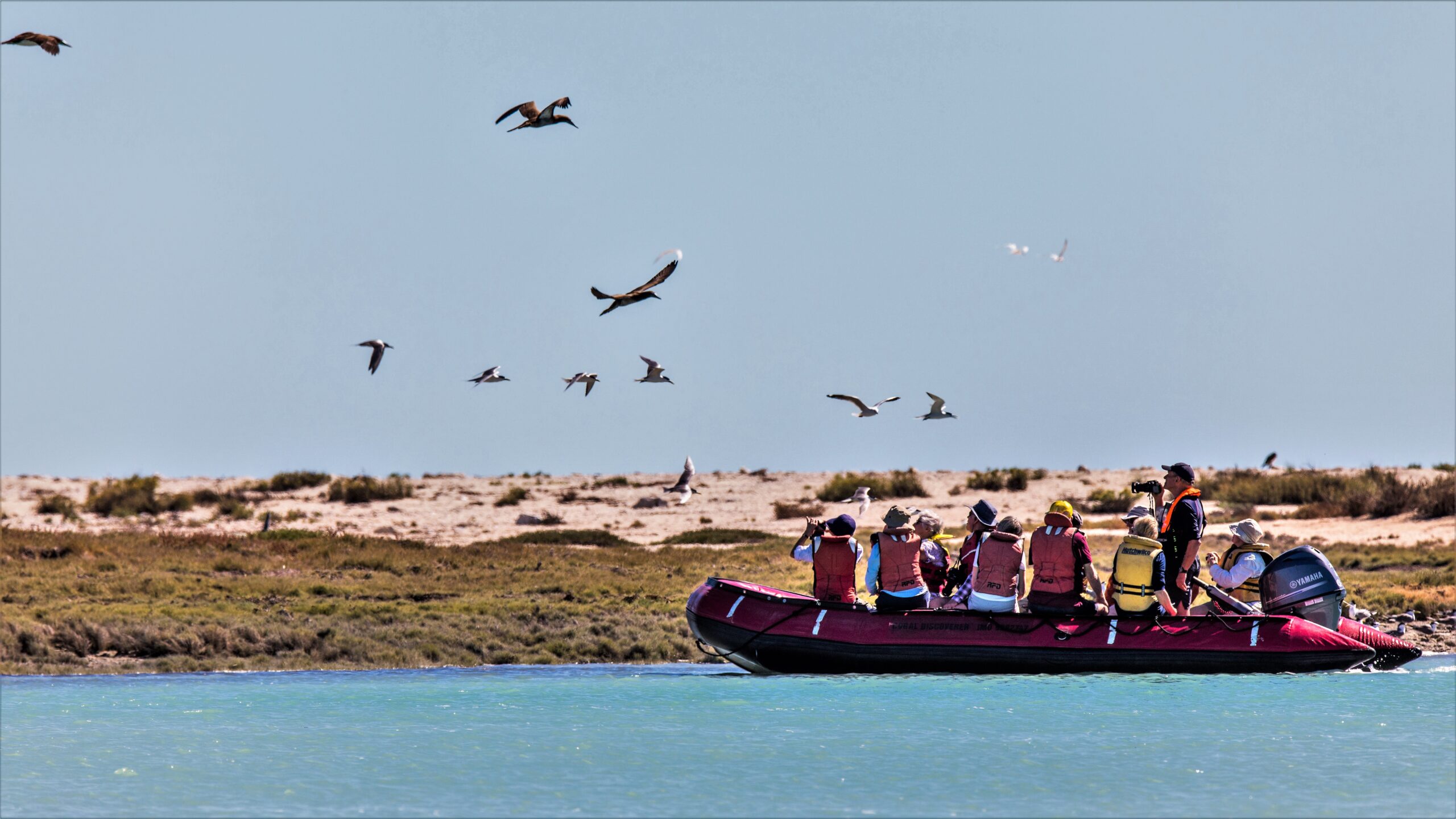
Lacepede Islands
Many species of seabirds are seen here in large numbers. Most common are flocks of Brown Booby, Lesser Frigatebird, Crested Tern, Lesser Crested Tern, Caspian Tern, Bridled Tern and Common Noddy. Other species include Roseate Tern, Silver Gull, Pelican, Pied Cormorant, Nankeen Night Heron, Red-capped Plover, Pied Oystercatcher, Sooty Oystercatcher. Masked Booby has been reported here. Large flocks of migratory shorebirds are seen here and usually are a mix of several species that are often difficult to identify. These shorebird species include Bar-tailed Godwit, Eastern Curlew, Whimbrel, Great Knot, Greater Sand Plover, Lesser Sand Plover, Red-necked Stint, Ruddy Turnstone, Terek Sandpiper, Sharp-tailed Sandpiper, Curlew Sandpiper, Grey-tailed Tattler and Common Greenshank. Less common are Black-tailed Godwit, Wandering Tattler and Red Knot.
Broome
Several Osprey nests on the wharf with platforms put in place by locals. Eastern Reef Egret, Whistling Kite, Pied Cormorant are frequently seen in the area. The Broome Bird Observatory is worth a visit where time allows.

